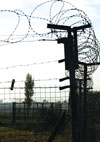

Interview with Andreas Wolf from Dallmeier.
Perimeter protection is an extensive area of application. It includes installations such as lighting, access barriers and enclosures as well as detection sensors for monitoring property lines. We spoke to Andreas Wolf, product manager intelligent video surveillance at Dallmeier, about advanced video detection on the perimeter.
How can video surveillance contribute to perimeter protection?
Video technology used in perimeter protection has two important functions. For one thing video recordings can be used to visually verify alarms that were triggered by detectors on a fence, for example. Additionally, video can actively detect events along property lines or within a defined area.
In principal, three things are needed: Firstly you need cameras that will provide good quality images, even with little residual light in order to be able to carry out an analysis. Secondly, one needs a video analysis system with recording capability, and thirdly, a video and alarm management system. Apart from that there should be suitable locations for installing the cameras.
From the point of view of a manufacturer of video analysis systems, what needs to be taken into account when planning such a system?
First of all the customer’s requirements need to be clarified. For every project, those requirements are individual and decisively influence the positioning of the cameras and the processing of alarms.
How do the cameras have to be installed?
With conventional perimeter protection, the cameras are installed in close vicinity to the property line. For this purpose, masts are usually used that also carry the lighting. The cameras should be installed high enough so that movements towards the camera can be reliably detected. Generally, installation heights of four to six metres are required. It is important to make sure that the mast is resilient to get judder-free images even in windy conditions. The lighting should be as far away from the camera as possible in order to have a homogenous illumination and reduce disturbances caused by insects in front of the camera.
What is detected by video?
In principle, a video analysis detects the moving parts in the video. Those moving objects can be people and vehicles but also branches, grass, animals or shadows. The detected objects are subject to a comprehensive validity check. Depending on the analysis system a certain number of alarms are triggered.
A validity check evaluates whether or not a given object is something that fits the alarm grid. Important criteria are the minimal size, which limits the depth of detection, and the maximal size of an object. A further criterion is the behaviour of the object ie, how it is moving and where to.
What triggers an alarm?
An alarm as in the sense perimeter protection can be defined as follows: “There is a (valid) object in a defined area, within the perspectively defined dimension, for longer than a minimum period of time, with a minimal movement in a defined direction.” If those criteria are met, an alarm is triggered. That is the case for example when a person climbs over a fence which is detected by a video analysis.
What happens to the alarm then?
When an alarm is triggered, two important steps are initiated. The alarm is sent to the video server which uses it as a recording trigger. The video server stores a parameterisable time period prior to and after the alarm and associates the alarm with the alarm image. The alarm is saved in a database and can be investigated at any time.
The second step deals with forwarding the alarm to the alarm management system. The management system decides how the alarm is to be processed. With video surveillance applications the standard reaction would be to display on a monitor. Further actions depend on the demands of the customer.
Does it actually work, too?
Video analysis is not like a light bulb that either gives light or does not. Video analysis rather varies between being ‘problematic’ and being ‘really good’. Assessing how good video analysis works in a specific application requires expert knowledge.
The most important step in realising a satisfying perimeter protection is and remains professional planning. Professional installers should rely on support by the manufacturers, while the end customer needs to be thoroughly consulted regarding his demands. A sound solution can only be worked out in close exchange and communication with the customer.
For more information contact Dallmeier Southern Africa, +27 (0)11 979 4540, [email protected], www.dallmeier.com

© Technews Publishing (Pty) Ltd. | All Rights Reserved.